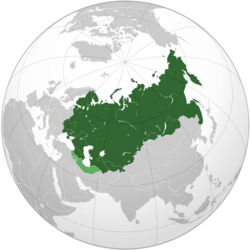Russian Republic
| History of Russia |
|---|
 |
|
|
The Russian Republic,[f] referred to as the Russian Democratic Federal Republic[g] in the 1918 Constitution, was a short-lived state which controlled, de jure, the territory of the former Russian Empire after its proclamation by the Russian Provisional Government on 1 September (14 September, N.S.) 1917 in a decree signed by Alexander Kerensky as Minister-Chairman and Alexander Zarudny as Minister of Justice.[1]
The government of the Russian Republic was dissolved after the Bolsheviks seized power by force on 7 November 1917. Nonetheless, a partially democratic election of the Constituent Assembly still took place later in November. On 18 January 1918, this assembly issued a decree, proclaiming Russia a democratic federal republic, but was also dissolved by the Bolsheviks on the next day after the proclamation.[2]
The Bolsheviks also used the name "Russian Republic" until the official name "Russian Socialist Federative Soviet Republic" was adopted in the Constitution of July 1918. The term is sometimes used erroneously for the period between the abdication of the Emperor Nicholas II on 3 March 1917 (16 March, N.S.) and the declaration of the Republic in September. However, during that period the status of the Russian political system was unresolved, left up to be decided by a future elected Constituent Assembly.[3]
History
[edit]Following the February Revolution, Emperor Nicholas II abdicated his throne and a Provisional Government was formed, under the leadership of Prince Georgy Lvov. The status of the monarchy was left unresolved.
Officially, the Republic's government was the Provisional Government, although de facto control of the country was contested between it, the soviets (chiefly the Petrograd Soviet), and various ethnic-based separatists (such as the Central Council of Ukraine). Soviets were political organizations of the proletariat, strongest in industrial regions, and were dominated by left-wing parties. Soviets, whose influence was supplemented with paramilitary forces, were occasionally able to rival the Provisional Government which had an ineffective state apparatus.
During his first weeks as prime minister, Lvov presided over a series of fleeting reforms which sought to radically liberalize Russia. Universal adult suffrage was introduced, freedoms of press and speech were granted, capital punishment abolished, and all legal restrictions of religion, class and race were removed.[4] Unable to rally sufficient support, he resigned in July 1917 in favor of his Minister of War, Alexander Kerensky.
The Government's control of the military was tenuous. Seamen of the Baltic Fleet, for example, had far-left views and openly engaged in political activism in the capital. Right-wing proclivities among the army officers were also a problem – Kerensky's attempt to dismiss Gen. Lavr Kornilov led to a failed coup.
Following the failure of Kornilov's coup, Kerensky proclaimed Russia to be a Republic on 1 September, establishing a Provisional Council as temporary parliament, in preparation to the elections of a Constituent Assembly. However, on 7 November 1917, the Bolsheviks seized power and dissolved both the Provisional Government and the Provisional Council.
Nonetheless, a partially democratic election of the Constituent Assembly still took place later in November. On 18 January 1918, this assembly issued a decree, proclaiming Russia a democratic federal republic under the name "Russian Democratic Federative Republic", However, the next day the Assembly was dissolved by the Bolsheviks.[2]
The Republic de jure continued to exist until the Bolsheviks proclaimed the creation of the Russian Soviet Republic on 25 January 1918.[5] In response, anti-Bolshevik forces proclaimed the Russian State in September 1918, under the leadership of the Provisional All-Russian Government.
Principal institutions
[edit]- Provisional Council of the Russian Republic
- Congress of Soviets
- Russian Provisional Government
- Directorate (Russia)
See also
[edit]- Russian Empire
- Russian Revolution
- Russian Civil War
- Soviet Union
- Petrograd Soviets
- World War I
- Bolshevists
- Elections in Russia
Notes
[edit]- ^ Pre-Reform Russian: Россійская Pеспублика
- ^ Pre-Reform Russian: Россійская Демократическая Федеративная Республика
- ^ Served as the prime minister of the provisional government from July 1917
- ^ De facto power seized by the Bolsheviks led by Vladimir Lenin
- ^ Dissolved after the first meeting
- ^ Russian: Российская Республика, romanized: Rossiyskaya Respublika, IPA: [rɐˈsʲijskəjə rʲɪsˈpublʲɪkə].
- ^ Russian: Российская Демократическая Федеративная Республика, romanized: Rossiyskaya Demokraticheskaya Federativnaya Respublika.
References
[edit]- ^ The Russian Republic Proclaimed at prlib.ru, accessed 12 June 2017
- ^ a b Ikov, Marat Sal. "Round Table the Influence of National Relations on the Development of the Federative State Structure and on the Social and Political Realities of the Russian Federation". Prof.Msu.RU. Retrieved 9 February 2021.
However, historically, the first proclamation of the federation was made somewhat earlier - by the Constituent Assembly of Russia. In his short resolution of January 6 (18), 1918, the following was enshrined: "In the name of the peoples, the state of the Russian constituent, the All-Russian Constituent Assembly decides: the Russian state is proclaimed by the Russian Democratic Federal Republic, uniting peoples and regions in an indissoluble union, within the limits established by the federal constitution, Of course, the above resolution, which did not thoroughly regulate the entire system of federal relations, was not considered by the authorities as having legal force, especially after the dissolution of the Constituent Assembly.
- ^ Beevor, Antony (2022). Russia: Revolution and Civil War, 1917–1921. Penguin. p. 46. ISBN 9780593493885.
- ^ Figes, Orlando (2017). A People's Tragedy: A History of the Russian Revolution. Random House. p. 358. ISBN 9781448112647. Retrieved 22 May 2021.
- ^ "Коровин К.С. Идеологические основания Конституции РСФСР 1918 г." Genesis: исторические исследования. 9 (9): 15–30. September 2017. doi:10.25136/2409-868x.2017.9.24090. ISSN 2409-868X.
External links
[edit]- The Russian Republic proclaimed. Presidential Library
- Browder, R. P., Kerensky, A. F. The Russian Provisional Government, 1917: Documents. "Stanford University Press". Stanford, 1961. ISBN 9780804700238




